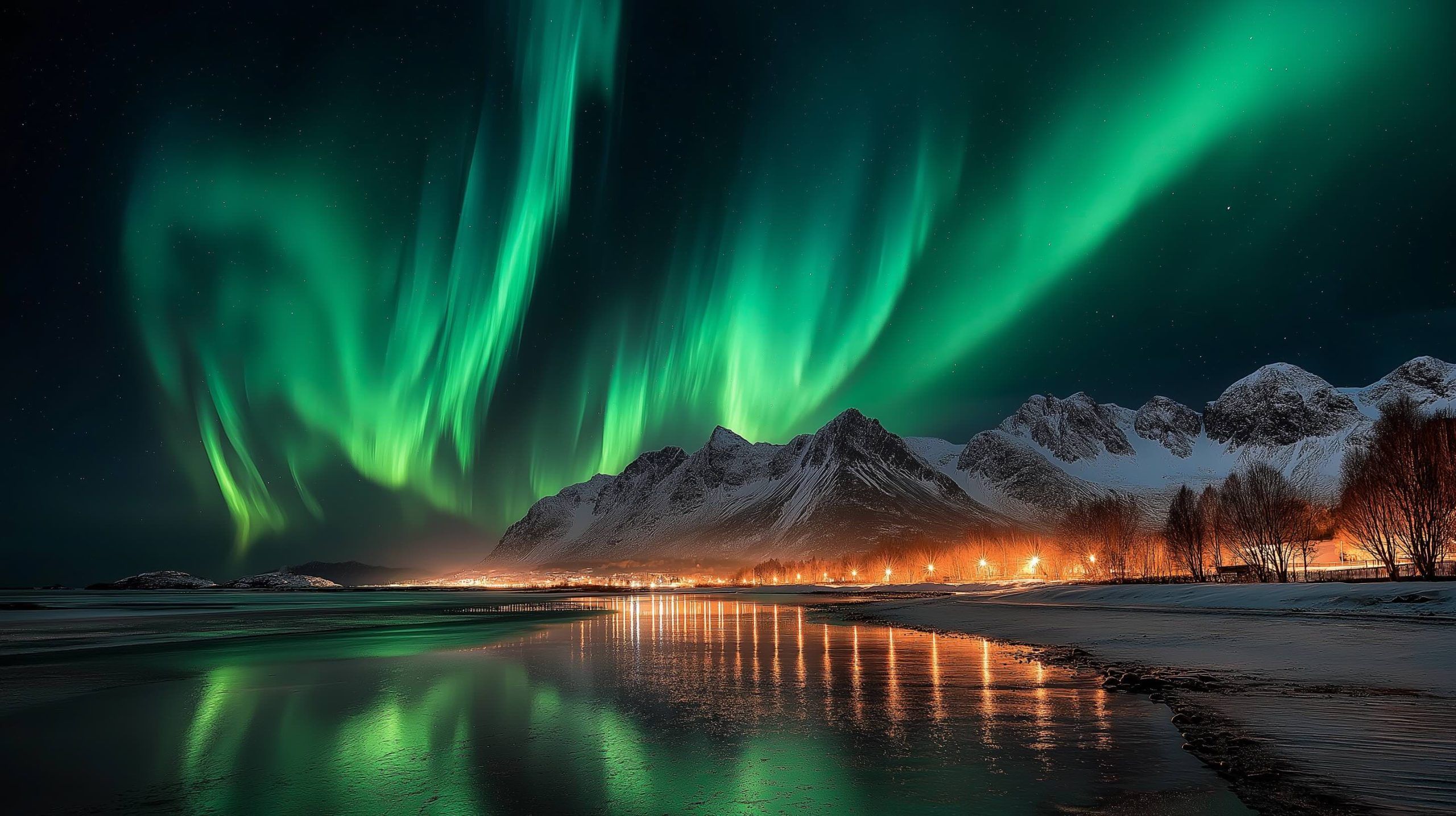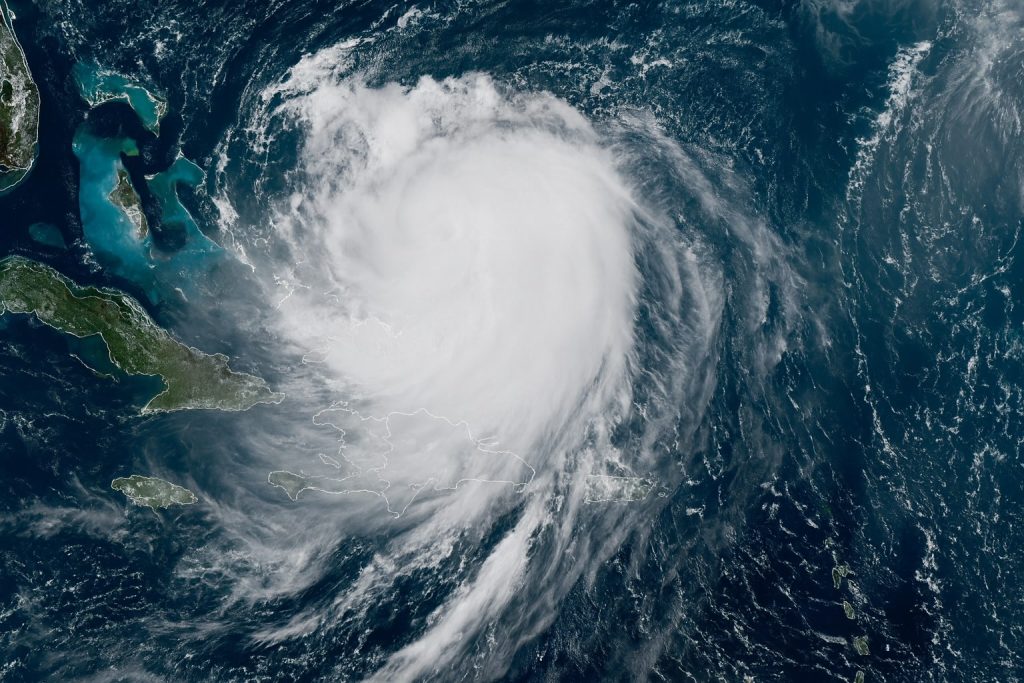- On August 19, 2025, NOAA’s Space Weather Prediction Center forecast a minor geomagnetic storm (G1) that could make the Northern Lights visible across 14+ U.S. states.
- Areas fully or partially within tonight’s aurora visibility zone include Alaska; Washington; Idaho; Montana; North Dakota; South Dakota; Minnesota; Wisconsin; Michigan; Maine; Vermont; New Hampshire; New York; Iowa; and northern Wyoming and Illinois.
- The best viewing window runs from about 10 p.m. to 4 a.m. local time, with geomagnetic activity peaking around midnight to early morning.
- The SWPC forecast projects a Kp index up to Kp 5 (G1), indicating auroras could reach the northern United States.
- The Moon is expected to rise very late in the early morning hours, making skies extra dark for viewing.
- A giant coronal hole rotated into Earth’s view and began spewing a high-speed solar wind toward our planet, driving the current aurora.
- There is a possibility that a coronal mass ejection could deliver a glancing blow that prolongs or intensifies the display into tomorrow.
- For photography, use a DSLR or mirrorless camera in manual mode with a wide fast lens (f/2.8 or faster) and ISO 800–1600 with 5–10 second exposures.
- Smartphone photographers can use Night Mode and stabilize the phone, while apps such as My Aurora Forecast, Aurora Alerts, Space Weather Live, and Aurorasaurus provide alerts for aurora activity.
- Scientists note the Sun is approaching its 11-year solar maximum, expected in 2025, suggesting more frequent Northern Lights displays through 2025–26.
Get ready for a rare summer light show. The aurora borealis (Northern Lights) might paint the night sky tonight (August 19, 2025) across more than a dozen U.S. states, thanks to a geomagnetic storm forecast by NOAA [1]. Skywatchers from the Pacific Northwest to New England – and even parts of the Midwest – have a chance to glimpse the aurora glowing low on the horizon or waving overhead in shades of green and purple. Below, find out where and when to look, what’s driving this phenomenon, expert insights on the forecast, how to photograph the aurora, and tips for safe, optimal viewing.
Where and When to See the Northern Lights Tonight (Aug 19, 2025)
NASA and NOAA officials are predicting a minor geomagnetic storm (G1) that could make the Northern Lights visible much farther south than usual tonight [2]. The aurora oval is expected to dip into the northern United States, potentially covering 14+ states. According to NOAA’s Space Weather Prediction Center (SWPC) aurora forecast, areas fully or partially within tonight’s aurora visibility zone include: Alaska, Washington, Idaho, Montana, North Dakota, South Dakota, Minnesota, Wisconsin, Michigan, Maine, Vermont, New Hampshire, New York, Iowa, and even northern parts of Wyoming and Illinois [3] [4]. In short, a huge swath of the country’s northern tier may get a peek at the auroral glow in the sky.
Timing is critical. The best window to look for auroras will be after darkness falls, roughly 10 p.m. until 4 a.m. local time [5]. NOAA forecasters predict geomagnetic activity peaking around midnight to early morning hours. In fact, the SWPC Kp index (a scale of geomagnetic disturbance) is forecast to reach Kp 5 (G1 storm) overnight, with heightened aurora chances between ~11 p.m. and 5 a.m. Eastern Time (0300–0900 UTC on Aug. 19) [6]. Because the Moon will rise very late (in the early morning hours), the sky will be extra dark in the evening, providing ideal contrast for any aurora displays [7]. Plan to be outside during the darkest hours before moonrise for the best chance of seeing those ethereal green and pink ripples.
Keep in mind that auroras may fade in and out. They often flare up in brief bursts rather than remaining bright all night. Experts recommend scanning the northern horizon periodically throughout the night. Don’t give up if you don’t see anything at 10 p.m. – it might appear later. Conversely, an aurora could show up earlier in the night, so start watching as soon as skies are fully dark.
Global outlook: This geomagnetic storm isn’t just for the U.S. – high-latitude regions around the world could see activity. Canadians in provinces bordering the U.S. (and of course Alaska) are almost certain to have auroras overhead if the storm hits as expected. In Europe, forecasters in the U.K. noted an “increasing possibility” of minor geomagnetic storms from Monday into Wednesday, with even a chance of a glancing blow from a solar eruption by Tuesday/Wednesday [8]. That means skywatchers in northern Europe (Scotland, Scandinavia, etc.) should also be on alert for auroras tonight and tomorrow. Essentially, anyone at upper-middle to high latitudes with clear dark skies has a shot at auroral sightings during this event.
What’s Causing This Aurora Display? (Solar Storm Forecast Explained)
This week’s auroras are powered by a bout of space weather. A few days ago, a giant coronal hole – an open gap in the Sun’s magnetic field – rotated into Earth’s view and began spewing a high-speed stream of solar wind toward our planet [9] [10]. That solar wind stream is now buffeting Earth’s magnetic field, sparking minor geomagnetic storm conditions. Essentially, charged particles from the Sun are slamming into our upper atmosphere, exciting atoms and causing them to glow – hence the “Northern Lights” in our skies.
“Late on 18 Aug, conditions are likely to increase to active levels followed by G1 (Minor) geomagnetic storm levels on 19 Aug. Active conditions are likely on 20 Aug,” NOAA predicts in its official forecast [11]. In other words, the storm was expected to ramp up Monday night (Aug 18) to minor G1 strength by tonight (Aug 19), then gradually taper off after Wednesday. This timing has played out as anticipated so far, with initial solar wind impacts Monday that primed the magnetosphere for potential auroras tonight [12].
The U.K. Met Office also weighed in on the situation, noting “an increasing possibility during Monday of minor geomagnetic enhancement due to an arriving fast wind, with the possibility of a Coronal Mass Ejection glance Tuesday into Wednesday.” [13] In plain language, space-weather scientists are saying that the coronal hole’s solar wind is the main driver of the current aurora, but an additional solar eruption (CME) may deliver a glancing blow that prolongs or intensifies the light show into tomorrow. There is still some uncertainty, but if that CME material strikes Earth’s magnetic field, it could sustain auroral activity for another night. <div><small>Aurora science: A geomagnetic storm occurs when the solar wind disturbs Earth’s magnetic field. NOAA rates storms from G1 (Minor) to G5 (Extreme). Tonight’s storm is predicted to be G1, which is enough to push auroras into the northern U.S. but typically not much farther. Auroras appear when energetic particles spiral down Earth’s magnetic field lines and collide with atmospheric gases, causing those gases to emit light (oxygen produces green or red light; nitrogen yields pink or blue):contentReference[oaicite:13]{index=13}:contentReference[oaicite:14]{index=14}.</small></div>
Notably, this aurora event comes amid an upswing in solar activity. The Sun is approaching the peak of its 11-year cycle (the solar maximum), expected in 2025. We’ve seen an increase in solar flares, sunspots, and geomagnetic storms over the past year. NOAA has noted that solar activity is on the rise through 2025–26 as we head toward the cycle’s peak, meaning more frequent Northern Lights displays can be expected during the next year or two [14]. In short, the Sun is wide awake right now, and nights like tonight might become a bit more common – so it’s a great time to be an aurora watcher.
Viewing Tips for the Best Aurora Experience
Catching the Northern Lights, especially at lower latitudes, can be hit-or-miss – but you can maximize your odds with some smart planning. Here are some expert-backed tips for optimal aurora viewing:
- Go Dark (Avoid Light Pollution): City lights are the aurora’s worst enemy. Plan to get away from urban light pollution – even a 20–30 minute drive outside of town can dramatically improve visibility. The darker the sky, the better [15]. Find a safe, dark location like a countryside field, hill, lakeside, or state park. Once there, turn off any white lights (use a red flashlight if needed for safety) and let your eyes adjust to the darkness for at least 15–20 minutes.
- Face North & Get a Clear View: Auroras will show up to the north of your location (for those in the Northern Hemisphere). Find a spot with an unobstructed northern horizon – no tall buildings or trees blocking your view. If you’re at the southern edge of the aurora visibility zone, the display will likely be low on the horizon, possibly just a greenish glow or spikes peeking up. NOAA notes that the aurora doesn’t have to be overhead – under strong conditions it can be seen up to 1000 km (600+ miles) away on the horizon if it’s bright enough [16]. So a clear horizon view to the north is key. If you live in a hilly or mountainous area, try to get to a north-facing slope or ridge to avoid looking through too much ground-level haze.
- Timing Is Everything: As mentioned, 10 p.m. to 4 a.m. is the general window for tonight’s aurora opportunity [17]. Within that, many aurora chasers recommend around midnight to 2 a.m. as historically productive hours for geomagnetic activity. That said, keep an eye out as soon as skies get fully dark (some reports of faint aurora have even come in as early as 9–10 p.m.) and continue to periodically scan until dawn. Be patient – the aurora can flicker in and out. It might suddenly strengthen for a few minutes and then fade again. Give yourself at least an hour of watching, if not the whole night. And if you can, monitor space weather alerts (more on that below) which might tip you off if a particularly strong surge is incoming.
- Check the Weather: No matter how strong a solar storm is, you won’t see a thing if clouds cover your sky. Check your local weather forecast for tonight. High, thin clouds can dull the aurora, and low thick clouds will block it entirely. If your area is cloudy, you might consider a drive to find clearer skies if possible (safety first, of course). Likewise, humidity or haze can affect visibility – the clearer and drier the air, the better. Cold fronts often bring clear, crisp air behind them, which is great for stargazing and auroras.
- Stay Safe & Comfortable: Venturing out at night requires some caution. If you drive to a remote area, park in a safe location completely off the road. Use hazard lights if needed when stopping, and be mindful of traffic. It’s a good idea to bring a friend or let someone know where you’re going, especially if you’ll be in an isolated spot. Dress in warm layers (even in August, nighttime temperatures can drop significantly, and standing still stargazing can get chilly). Bring something to sit or lie down on – aurora watching can involve a lot of looking up or waiting around. Snacks, a warm drink, and other comforts can make the night more enjoyable. Lastly, respect private property and park rules – don’t trespass in your quest for darkness; many parks are open late or all night for exactly this purpose.
- Know What to Look For: If you’ve never seen the aurora, you might expect vivid green streaks right away. But at mid-latitudes, the aurora often starts as a faint grayish or whitish glow or cloud that doesn’t quite look like a normal cloud. It may slowly brighten or form pillars, ripples, or curtains. Color might be subtle to the naked eye – some observers only notice pale glows, while long-exposure photos show bright green or purple. If you suspect a faint aurora, try taking a long exposure photo (several seconds) on your camera or phone; the camera sensor may pick up telltale green/pink colors that confirm it’s the Northern Lights [18]. As your eyes dark-adapt, you might start to see tinges of green or purple, especially along the lower edge of an aurora arc. Give it time, and don’t get discouraged if it’s not bright green like the photos – any aurora sighting this far south is special!
- Aurora Alerts & Resources: Consider using an app or service to alert you of strong aurora activity. The nonprofit citizen science project Aurorasaurus offers alerts based on real-time sightings reported by users [19]. There are also smartphone apps (such as My Aurora Forecast, Space Weather Live, etc.) that can send notifications when geomagnetic activity increases or when aurora is likely in your location [20]. Following NOAA Space Weather Prediction Center or space weather scientists on social media (X/Twitter) is another way to get live updates overnight. We’ve also listed some official resources at the end of this report.
By following these tips – find a dark spot, look north, watch during the peak hours, and stay patient – you’ll give yourself the best shot at witnessing the Northern Lights if they appear.
How to Photograph the Aurora (DSLR, Mirrorless or Smartphone)
Seeing the aurora is one thing – capturing it on camera is another thrill! The good news is that modern cameras (and even phones) are very capable of photographing auroras, which can help you savor the experience later and share it. In fact, digital camera sensors are often more sensitive to faint aurora colors than our eyes, meaning your camera might pick up a vivid display even if you only see a dull glow [21]. Here are some practical photography tips for different devices:
📷 Shooting with a DSLR or Mirrorless Camera
- Use Manual Settings: Switch your camera to manual mode (M) so you have full control [22]. Automatic modes won’t know how to expose for the aurora in a dark sky.
- Focus to Infinity: In the dark, cameras struggle to autofocus. Set the lens to manual focus and adjust it to infinity (the ∞ mark) or use live view to focus on a bright star. It’s wise to do a few test shots and tweak focus until stars appear sharp – once set, do not bump the focus ring [23]. (Tip: Some lenses focus past infinity; the perfect focus point might be just a hair before the infinity mark.)
- Wide and Fast Lens: Auroras are typically faint, so you want to collect as much light as possible, as quickly as possible. Use your widest aperture lens – ideally f/2.8 or lower [24]. Wide-angle lenses (e.g. 14mm, 20mm, or a kit lens at 18mm) are great for auroras because they cover more sky and allow longer exposures without star trails. A lens with f/2.8 or f/1.8 is ideal; if your lens is slower (f/4, f/5.6), it will still work but you might need higher ISO or longer exposure.
- ISO and Exposure: A good starting point for aurora is ISO 800 to 1600 and shutter speed of 5–10 seconds [25]. Take a test shot and see how it looks. If the photo is too dark, either increase the ISO (1600–3200 or more) or use a longer exposure (15 seconds, 20 seconds). If the photo is too bright (or aurora features look washed out), drop the ISO or use a shorter exposure. There’s a trade-off: higher ISO makes the camera more light-sensitive but also adds noise/grain. Every camera handles ISO differently; ISO 1600–3200 is usually a safe range on modern DSLRs/mirrorless. Adjust exposure on the fly until the images look good. Every aurora display differs – if the aurora suddenly brightens or moves rapidly, you’ll want a shorter exposure (to avoid it blurring) and maybe lower ISO [26]. If it’s very faint and static, you can get away with longer exposures. Experiment – that’s half the fun!
- White Balance: Don’t stress too much about color settings in the field. Auto white balance usually is fine. If the auto results look odd, you can try a manual white balance around 3500K (a common color temp for night sky photos) [27]. If you shoot RAW, you can always adjust white balance later in processing without quality loss.
- Stability is a Must:Mount your camera on a tripod – long exposures demand it [28]. Even a 1-second exposure will blur if handheld. No tripod? Improvise by steadying the camera on a wall, car roof, or rock (and use the self-timer to avoid jostling it). Also, use a remote shutter or self-timer (2-second delay) to fire the camera without touching it, eliminating shake [29].
- Additional Tips: Use RAW format if you’re comfortable with post-processing – it gives more leeway to adjust exposure and bring out details later [30]. Bring spare batteries; long exposures in cold conditions drain batteries faster [31]. It helps to practice your camera settings at home (in a dark room or on stars) so you’re familiar with the controls by the time you’re standing under a cold, dark sky. And don’t forget to just enjoy the moment – snap some photos, but also take breaks to marvel at the aurora with your own eyes!
🤳 Shooting with a Smartphone
Believe it or not, your smartphone can capture respectable aurora photos nowadays, especially high-end models. The cameras and software have come a long way. Here’s how to make the most of your phone:
- Use Night Mode: Most newer smartphones (iPhone, Samsung Galaxy, Google Pixel, etc.) have a “Night Mode” or low-light mode that automatically takes a longer exposure when it’s dark [32]. Activate that feature – on some phones it kicks in automatically in the camera app when the scene is dark enough, on others you might toggle a Night Sight or Night Mode. This lets the phone gather more light from the aurora. Keep the phone very still while it’s taking the shot – night mode exposures can be several seconds long, and any movement will blur the image [33]. Pro tip: stabilize your phone by using a small tripod or even bracing it on a steady surface (fence, rock, car hood) and use a timer or remote shutter (or just very steady hands).
- Try Manual Camera Apps: Some smartphone camera apps (or built-in “Pro” modes) let you manually set ISO and shutter speed. If so, treat it like a mini-DSLR: choose a high ISO (400–800 to start) and an exposure of a few seconds (5–10s if available) [34]. Focus to infinity if that’s an option (or just focus on the farthest thing or star you can). Many phones don’t let you do very long exposures natively, but third-party apps (like NightCap, ProCam, Camera FV-5, etc.) can sometimes give more control. There are also specialized apps for aurora/astrophotography on phones.
- Keep the Lens Stable and Clear: Because phone sensors are small, they benefit even more from stability. If you don’t have a phone tripod, improvise: lean it against a rock, use a bean bag, etc. And make sure the lens is clean – smudges will create glare with bright aurora or stars.
- Use Burst/Video for Lucky Shots: Another trick: some people record a video of the aurora (which will likely just show a faint fuzz) and later extract frames or use the video to stack images. This is advanced, but apps like NightCap on iPhone can record long-exposure video. Alternatively, use burst mode to take many photos and hopefully one is during a bright moment.
- Let the Sensor Do the Work: Remember, your phone sensor might “see” the aurora better than your eyes. Don’t be shocked if a 3-second phone photo shows a green sky where you only saw gray. Phones can pick up those colors if given enough exposure time [35]. So even if you think nothing is there, try a couple of shots – you might be rewarded with a surprise aurora capture!
Finally, whether using pro gear or a phone, share your shots! Not only with friends, but consider reporting them to citizen science projects or aurora galleries. Your photos (even simple ones) contribute to our collective understanding and enjoyment of this phenomenon. And if they don’t turn out – no worries, the real treasure is having witnessed the aurora with your own eyes.
Official Aurora Trackers & Further Resources
If you’re hungry for more information or want to follow the aurora forecasts in real time, here are a few reliable resources:
- NOAA Space Weather Prediction Center (SWPC): NOAA’s SWPC offers a *3-Day Aurora Forecast and an interactive Aurora Dashboard. Their website provides a map of the aurora oval and “view line” for tonight, showing how far south the aurora might be visible [36] [37]. They also post alerts and updates as geomagnetic conditions change. Track the latest aurora forecast on NOAA’s page here [38].
- SpaceWeather.com: A longtime favorite of sky enthusiasts, this site gives daily space weather news. It even issued an alert that “high-latitude sky watchers should remain alert for auroras on Aug. 19” in light of the incoming solar wind [39]. Spaceweather.com posts real-time updates, solar wind data, and often showcases aurora photos from observers.
- Aurorasaurus: As mentioned, Aurorasaurus is a citizen-powered project that maps aurora sightings. Users report when/where they see the aurora, and you can get notifications if reports pop up near your area [40]. It’s a great way to know if people one state north of you suddenly start seeing aurora – giving you a heads up to go outside and look!
- Mobile Apps: Numerous apps provide aurora forecasts and alerts. Some popular ones (free or low-cost) include My Aurora Forecast, Aurora Alerts, Space Weather Live, and Northern Lights Aurora Forecast. These apps often combine data from NOAA with your location to give a probability of seeing aurora, and can send push notifications when conditions are favorable. As an example, My Aurora Forecast & Alerts is one app that can notify you if the Kp index is high enough for your area [41].
- Local Astronomy Clubs/Social Media: Don’t underestimate the power of community. Check if local astronomy or stargazing groups on Facebook, Reddit, or Twitter are discussing the aurora. Often, enthusiasts will post real-time updates like “faint glow visible now in northern sky from [Your State]!” which can be super helpful. (But also beware of doctored photos or old images recirculating – always confirm the time/date of any reports.)
Tonight’s potential aurora is a must-see celestial event – a chance for many Americans to witness the Northern Lights without traveling to the Arctic. If skies cooperate, it could be an unforgettable spectacle. Experts say geomagnetic conditions are lining up for a minor aurora display over a wide region [42] [43]. So plan a little sky-watching adventure if you can: find a dark spot, look north, stay up late, and keep your camera ready. The aurora doesn’t follow a strict schedule, but that’s part of the magic. With a bit of luck, you might catch the dance of the Northern Lights – and join thousands of others across 14+ states in marveling at one of nature’s most enchanting shows [44] [45].
Happy aurora hunting, and clear skies! 🌌
Sources:
- National Oceanic and Atmospheric Administration (NOAA) – Space Weather Prediction Center updates [46] [47]
- U.K. Met Office space weather advisory [48]
- Fast Company – Aurora borealis August 2025: Northern lights may be visible in 14 states tonight [49] [50]
- ABC News – Northern lights could be visible in more than a dozen US states tonight [51] [52]
- Space.com – Northern lights may be visible in these 15 states tonight [53] [54]
- Travel + Leisure – Northern Lights Expected Over 15 U.S. States Tonight [55] [56]
- People – How to Watch the Northern Lights from These States Tonight (Valerie Mesa) [57]
- NASA – Guide to Photographing Auroras [58] [59]
- NOAA / NASA – Aurora science background [60] [61]
- SpaceWeather.com – Aurora alerts and forecast updates [62]
- Aurorasaurus project – Citizen aurora reports [63]
References
1. www.fastcompany.com, 2. www.fastcompany.com, 3. www.space.com, 4. people.com, 5. abcnews.go.com, 6. www.space.com, 7. abcnews.go.com, 8. www.travelandleisure.com, 9. www.space.com, 10. www.space.com, 11. www.travelandleisure.com, 12. spaceweather.com, 13. www.travelandleisure.com, 14. www.fastcompany.com, 15. abcnews.go.com, 16. www.travelandleisure.com, 17. abcnews.go.com, 18. abcnews.go.com, 19. abcnews.go.com, 20. www.space.com, 21. science.nasa.gov, 22. science.nasa.gov, 23. science.nasa.gov, 24. science.nasa.gov, 25. science.nasa.gov, 26. science.nasa.gov, 27. science.nasa.gov, 28. science.nasa.gov, 29. science.nasa.gov, 30. science.nasa.gov, 31. science.nasa.gov, 32. science.nasa.gov, 33. science.nasa.gov, 34. science.nasa.gov, 35. science.nasa.gov, 36. www.space.com, 37. www.space.com, 38. www.fastcompany.com, 39. spaceweather.com, 40. abcnews.go.com, 41. www.space.com, 42. www.travelandleisure.com, 43. spaceweather.com, 44. www.fastcompany.com, 45. www.space.com, 46. www.fastcompany.com, 47. www.travelandleisure.com, 48. www.travelandleisure.com, 49. www.fastcompany.com, 50. www.fastcompany.com, 51. abcnews.go.com, 52. abcnews.go.com, 53. www.space.com, 54. www.space.com, 55. www.travelandleisure.com, 56. www.travelandleisure.com, 57. people.com, 58. science.nasa.gov, 59. science.nasa.gov, 60. science.nasa.gov, 61. science.nasa.gov, 62. spaceweather.com, 63. abcnews.go.com









